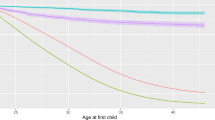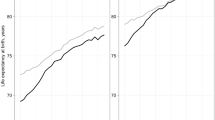Abstract
Background
Most studies on disability pension (DP) have focused on work conditions, socio-economic status and other contemporary factors. We wanted to study possible determinants of an early DP with a life course perspective within a large register-based cohort, with a main focus on the biological and social factors from childhood.
Methods
We established a longitudinal, population-based cohort of all persons liveborn in Norway between 1967 and 1976. Through linkage between several national registers we obtained personal data on biological/health related as well as social background factors. After excluding persons who died, emigrated or were granted a DP before age 20 years (at which age follow-up started) and persons who did not become gainfully employed during the study period, the study population consisted of 595,393 persons. They were categorized into four strata according to gender and educational attainment. Adjusted hazard ratios (HR) for granting a DP until the end of 2003 and the corresponding population attributable risks (PAR) were computed.
Results
A total of 9,649 persons (1.6%) were granted a DP during follow-up. The disability risk was slightly higher among women than among men (1.7% vs. 1,5%). The following PARs were found: birth weight below the mean 5.7%, chronic childhood disease 6.8%, maternal marital status 4.4% and parental disability 8.8%. Low educational achievement was highly associated with DP, with a PAR more than twice as high as the overall PAR for the childhood factors.
Conclusions
Early DP is associated with several biological and social background factors from childhood. It also shows a strong dependency on educational achievement.


Similar content being viewed by others
References
Zeitzer IR. Recent European trends in disability and related programs. Soc Secur Bull 1994;57:21–6.
Moncrieff J, Pomerleau J. Trends in sickness benefits in Great Britain and the contribution of mental disorders. J Public Health Med 2000;22:59–67.
Gjesdal S, Lie RT, Maeland JG. Variations in the risk of disability pension in Norway 1970–99. A gender-specific age-period-cohort analysis. Scand J Public Health 2004;32:340–8.
Trygdestatistisk årbok 2005 (Annals of the National Insurance Administration 2005) [Report]. Oslo: Rikstrygdeverket, utredningsavdelingen, 2005.
http://www.oecd.org/dataoecd/4/12/36892986.pdf#search=%22%22inclusive%20workplace%22%22.
Ben-Shlomo Y, Kuh D. A life course approach to chronic disease epidemiology: conceptual models, empirical challenges and interdisciplinary perspectives. Int J Epidemiol 2002;31:285–93.
Kuh D, Ben-Shlomo Y, Lynch J, Hallqvist J, Power C. Life course epidemiology. J Epidemiol Community Health 2003;57:778–83.
Power C, Kuh D. Life course development of unequal health. In: Siegrist J, Marmot M, editors. Social inequalities in health. New evidence and policy implications. Oxford: Oxford University Press; 2006. p. 27–53.
Krause N, Lynch J, Kaplan GA, Cohen RD, Goldberg DE, Salonen JT. Predictors of disability retirement. Scand J Work Environ Health 1997;23:403–13.
Holte HH, Tambs K, Bjerkedal T. Manual work as predictor for disability pensioning with osteoarthritis among the employed in Norway 1971–1990. Int J Epidemiol 2000;29:487–94.
Holte HH, Tambs K, Bjerkedal T. Physically demanding situations as predictors of disability pensioning with soft tissue rheumatism among persons 30–39 years old in Norway, 1981–90. J Rheumatol 2002;29:1760–6.
Hayward MD, Grady WR, Hardy MA, Sommers D. Occupational influences on retirement, disability, and death. Demography 1989;26:393–409.
Hasle H, Jeune B. The significance of working conditions with regard to disability pensions. A case-controlled study among unskilled workers. Ugeskr Laeger 1989;151:1929–31.
Upmark M, Lundberg I, Sadigh J, Bigert C. Conditions during childhood and adolescence as explanations of social class differences in disability pension among young men. Scand J Public Health 2001;29:96–103.
Krokstad S, Johnsen R, Westin S. Social determinants of disability pension: a 10-year follow-up of 62 000 people in a Norwegian county population. Int J Epidemiol 2002;31:1183–91.
Rognerud MA, Kruger O, Gjertsen F, Thelle DS. Strong regional links between socio-economic background factors and disability and mortality in Oslo, Norway. Eur J Epidemiol 1998;14:457–63.
Hagen KB, Holte HH, Tambs K, Bjerkedal T. Socioeconomic factors and disability retirement from back pain: a 1983–1993 population-based prospective study in Norway. Spine 2000;25:2480–7.
Krokstad S, Westin S. Disability in society-medical and non-medical determinants for disability pension in a Norwegian total county population study. Soc Sci Med 2004;58:1837–48.
Mansson NO, Rastam L, Eriksson KF, Israelsson B. Socioeconomic inequalities and disability pension in middle-aged men. Int J Epidemiol 1998;27:1019–25.
Guberan E, Usel M. Permanent work incapacity, mortality and survival without work incapacity among occupations and social classes: a cohort study of ageing men in Geneva. Int J Epidemiol 1998;27:1026–32.
Mansson NO, Merlo J. The relation between self-rated health, socioeconomic status, body mass index and disability pension among middle-aged men. Eur J Epidemiol 2001;17:65–9.
Hasle H, Jeune B. [The significance of childhood conditions with regard to disability pensions. A case-controlled study among unskilled workers]. Ugeskr Laeger 1989;151:1926–8.
Gjesdal S, Bratberg E. The role of gender in long-term sickness absence and transition to permanent disability benefits. Results from a multiregister based, prospective study in Norway 1990–1995. Eur J Public Health 2002;12:180–6.
Allebeck P, Mastekaasa A. Swedish Council on Technology Assessment in Health Care (SBU). Chapter 5. Risk factors for sick leave—general studies. Scand J Public Health Suppl 2004;63:49–108.
Upmark M, Lundberg I, Sadigh J, Allebeck P, Bigert C. Psychosocial characteristics in young men as predictors of early disability pension with a psychiatric diagnosis. Soc Psychiatry Psychiatr Epidemiol 1999;34:533–40.
Upmark M, Thundal KL. An explorative, population-based study of female disability pensioners: the role of childhood conditions and alcohol abuse/dependence. Scand J Public Health 2002;30:191–9.
Kuh DJ, Wadsworth ME, Yusuf EJ. Burden of disability in a post war birth cohort in the UK. J Epidemiol Community Health 1994;48:262–9.
Wadsworth ME, Butterworth SL, Hardy RJ, et al. The life course prospective design: an example of benefits and problems associated with study longevity. Soc Sci Med 2003;57:2193–205.
Irgens LM. The Medical Birth Registry of Norway. Epidemiological research and surveillance throughout 30 years. Acta Obstet Gynecol Scand 2000;79:435–9.
Bjerkedal T, Thune O. Basic and attendance benefits to children–extent and medical causes. Tidsskr Nor Laegeforen 1994;114:1941–5.
Norwegian standard classification of education. Revised 2000 [Report]. Oslo-Kongsvinger: Statistics Norway, 2003.
Greenland S, Drescher K. Maximum likelihood estimation of the attributable fraction from logistic models. Biometrics 1993;49:865–72.
Hansen BM, Dinesen J, Hoff B, Greisen G. Intelligence in preterm children at four years of age as a predictor of school function: a longitudinal controlled study. Dev Med Child Neurol 2002;44:517–21.
Kristensen P, Bjerkedal T, Irgens LM, Gravseth HM, Brevik JI. Impact of life course determinants on work participation among young Norwegian men. Norwegian Journal of Epidemiology 2005;15:65–74. http://www.ub.ntnu.no/journals/norepid/2005–1/051_13_Kristensen.pdf.
Bjerkedal T, Thune O, Irgens LM. Early identification of children with increased risk of permanent occupational disability. Tidsskr Nor Laegeforen 1999;119:652–6.
Markestad T. Young disabled. Tidsskr Nor Laegeforen 1998;118:2304.
Kristensen P, Bjerkedal T, Brevik JI. Long term effects of parental disability: a register based life course follow-up of Norwegians born in 1967–1976. Norwegian Journal of Epidemiology 2004;14:97–105. http://www.ub.ntnu.no/journals/norepid/2004-1/2004(1)_19-Kristensen.pdf.
Glendinning A, Love JG, Hendry LB, Shucksmith J. Adolescence and health inequalities: extensions to Macintyre and West. Soc Sci Med 1992;35:679–87.
Aro S, Aro H, Keskimaki I. Socio-economic mobility among patients with schizophrenia or major affective disorder. A 17-year retrospective follow-up. Br J Psychiatry 1995;166:759–67.
Timms D. Gender, social mobility and psychiatric diagnoses. Soc Sci Med 1998;46:1235–47.
Gjesdal S, Bratberg E. Diagnosis and duration of sickness absence as predictors for disability pension: results from a three-year, multi-register based* and prospective study. Scand J Public Health 2003;31:246–54.
Barker DJ. Maternal nutrition, fetal nutrition, and disease in later life. Nutrition 1997;13:807–13.
Acknowledgements
The study was supported financially by a grant from the Norwegian Research Council.
Author information
Authors and Affiliations
Corresponding author
Rights and permissions
About this article
Cite this article
Gravseth, H.M., Bjerkedal, T., Irgens, L.M. et al. Life course determinants for early disability pension: a follow-up of Norwegian men and women born 1967–1976. Eur J Epidemiol 22, 533–543 (2007). https://doi.org/10.1007/s10654-007-9139-9
Received:
Accepted:
Published:
Issue Date:
DOI: https://doi.org/10.1007/s10654-007-9139-9




